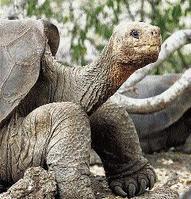
Lonesome George, the giant tortoise, is seen at the national park on the Galapagos islands in this April 29 file photo. Deemed by researchers to be the last of his species, the bachelor-for-life reptile has refused to mate with females and may even have lost the instinct for mating. - Reuters PUERTO AYORA, Ecuador (Reuters):
While scientists search for a mate for Lonesome George - the last known survivor of a species of Galapagos tortoise - some say the effort to fend off extinction may be in vain.
Even if a mate is found, George has not been interested in reproducing in the past and may not know how, former keepers and others who have worked with him said.
"The search is a long shot," said Linda Cayot, a science adviser for the Galapagos Conservancy and former keeper of George. "George may be physiologically incapable of reproducing."
Little interestin reproducing
Until recently, George was thought to be the last member of a species of giant tortoise found only on Pinta, one of the Galapagos Islands off Ecuador.
Earlier this year, however, scientists at Yale University in Connecticut said they had found a male tortoise on the island of Isabela, another Galapagos island, that was the offspring of a Pinta male and an Isabela female. That suggests there may be Pinta island tortoises on Isabela.
But even if a potential mate is found, George has shown little interest in reproducing with the female tortoises who are kept with him in his pen at the Darwin Research Center.
"He has problems ... he probably never saw a female and male of his own species reproducing," said Swiss biologist Sveva Grigioni, who worked with George 13 years ago.
Even when younger males were introduced to the females in the pen, George failed to get the idea.
Grigioni, now back in Switzerland, said she could normally get tortoises to ejaculate within minutes, but spent months manually stimulating George and never extracted semen from him.
Age is not George's problem. He is estimated at between 60 and 90 years old, and could live to be 200 and still reproduce, scientists say.
The visual differences in tortoises from different islands were among the features of the Galapagos that helped 19th-century British naturalist Charles Darwin formulate his theory of evolution.
Since then, the tortoises have been hunted by pirates for their meat and their habitat eaten away by goats introduced onto the islands.
George, who weighs 198 pounds (90 kilograms), was found on Pinta in 1971.
The possibility that he is not the last of his kind has drawn international notice.
International attention
The New York Times expressed a fear George could lose his kudos as 'the world's rarest creature', a feature that wins him donations from across the world.
"Until now he has been the main tourist draw at the Darwin Research Station, the prime example of what fund-raisers call charismatic megafauna."
But for Henry Nicholls, the author of Lonesome George: The Life and Loves of a Conservation Icon, a partner would bring more attention to the long-time bachelor and his home.
Ecuador has declared the islands at risk and the United Nations says efforts to protect them should continue George was feared to be last of his particular species, some 20,000 giant tortoises now live on the islands.
"Any findings will show that rather than being a static story with a dead end, this is an ongoing novel," Nicholls said. "Nobody will forget he was and will continue to be Lonesome George."

